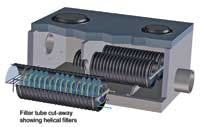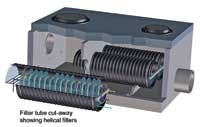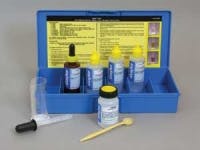By Darren Reed
• ITT Watermark, Mercy Corps collaborate to assist Hondurans in recovery from Tropical Storm Alma
Mercy Corps staff Chet Thomas and Mugar Dumitrache after setting up the new ITT filter system in Siguatepeque , Honduras
Only two days after announcing the partnership, ITT Watermark received a request for help from Honduras. Steady, torrential rains and flooding caused by Tropical Storm Alma in May 2008, the most destructive tropical storm to hit Honduras in a decade, devastated the country and destroyed vital water sources, leaving thousands of people without access to safe, clean drinking water.
A local press interview with Mercy Corps staff about the project.The UN Office for Coordination of Humanitarian Affairs reported that the intense rainfall affected 320,000 people in Honduras. Aid workers were comparing the resulting devastation to 1998's Hurricane Mitch, which killed more than 6,500 people in Honduras. According to Chet Thomas, Mercy Corps' representative in Honduras, although the number of deaths in this disaster were much less -- 60 people -- the flooding was worse.
Within a week of receiving the call for help, ITT Watermark and Mercy Corps assembled a response team, comprising two engineers from ITT and three Mercy Corps specialists working in the area, to aid the people of La Libertad and Meambar in Honduras. Over the course of just seven days in November 2008, the team installed water treatment systems to provide 50,000 people access to clean, safe water.
ITT engineers provide training on the operation of a new potable water filtering system in La Libertad , Honduras
The following chronicles the coordinated global effort to make an impact in such a short amount of time:
Day One - Arrival in Tegucigalpa
When the call came in for help from Honduras, ITT quickly worked to arrange shipping of two portable water treatment systems to Tegucigalpa, Honduras from Bangkok, Thailand, where they were being stored. The equipment, which ITT sent via air freight, arrived within eight days to Tegucigalpa. Upon its arrival, Mercy Corps transported the equipment to a staging area in Siguatepeque, which would serve as a base of operations.
Day Two - Staging in Siguatepeque
Before installing the equipment in La Libertad and Meambar, ITT engineers conducted a brief, half-day training course for five local operators from Mercy Corps and ITT. The initial training, which took place at a nearby river, gave them practical training at every stage including site and water source selection, set up, operation, basic maintenance and distribution of water. Once Mercy Corps and ITT representatives completed the training, the team closed down for the day and prepared to head to La Libertad in the morning.
Days Three and Four - Installation in La Libertad
When the team arrived in La Libertad, the local people were taking what raw water they could from a dirty, muddy stream. But the raw water was high in particulates, bacteria and fecal contaminants, so they were boiling the water and trying to use as little as possible. It was clearly a desperate and unsafe situation.
Prior to the team's arrival, the local community, with Mercy Corps' help, had built a platform to hold the water tank. Unfortunately, the platform was a little too small. The team quickly recruited some local workers to help extend the platform an additional three and a half feet, which took a little over an hour to complete.
Local Mercy Corps staff Mugar Dumitrache and ITT engineers complete installation of water pumps.A newly installed potable water station in La Libertad, Honduras, with membrane bag for storage of treated water.
Once the platform was in place, ITT, with the help of Mercy Corps, immediately began training the two local operators who would be responsible for running the unit in cooperation with the town mayor and the town plumber. The team taught the operators how to monitor chlorination and maintain the system, including training on ensuring proper filtration. Upon completion of the training in La Libertad, the team was confident the community could successfully sustain pump operation and perform maintenance and repairs as necessary.
Days Five and Six - Installation in Meambar
The team now turned its focus to Meambar. The biggest challenge here was getting in and out of town each day. The road had been completely washed out in a number of places, mandating the use of all-terrain vehicles on the slow, treacherous drive. Although Meambar is only 35-40 kilometers from the base in Siguatepeque, the commute in and out of town took about two hours each way each day.
Unlike La Libertad, Meambar had a basketball court in the center of town with a solid concrete slab well-suited to serve as the equipment base. Prior to the team's arrival, a Mercy Corps representative cordoned off an area upstream where workers laid a pipeline to draw water into town.
Local Mercy Corps and ITT staff with the town's mayor after installation of the new filtering system providing precious potable water in La Libertad, Honduras.
As the team set up the equipment and began the training, local townspeople descended on the site, wanting to see what was going on and looking for ways to participate in the installation. Forty families in the area had been washed out of their homes, and helping with this installation was their way of paying back the community for taking care of them.
With so many people wanting to be involved, training proved challenging, so the town designated an area around the equipment to allow the team to focus the training on the operators. The Mercy Corps representatives that ITT trained when they first arrived did the majority of the training to reinforce what they had learned earlier in the week. Within two days, the team completed the training and the equipment was up and running, providing fresh and clean water to the Meambar community.
Day Seven - Project Completion
Having restored safe water to La Libertad and Meambar, it was time for the team to depart. After just seven days, 50,000 people now had access to clean, safe drinking water, and a lot of vulnerable people were now protected from diseases that would have otherwise caused severe illness or death.
With the help of local community members as well as ITT and Mercy Corps representatives, the team was able to change the lives of families in La Libertad and Meambar. Natural disasters, like the flooding in Honduras, hit with sudden fury and require urgent response through coordinated efforts like that of ITT Watermark.
Using five-gallon jugs and 500 ml personal use bottles, locals access water from the newly installed potable water station in La Libertad, Honduras
Conclusion
While ITT has provided water relief to other natural disaster sites in the past -- including the 2004 Indian Ocean tsunami, the 2007 flooding in Tabasco, Mexico, the 2008 earthquake in China and the typhoon in Myanmar -- working with Mercy Corps, ITT can now respond faster and make a more meaningful impact in disaster zones.
Now expanded with additional partners such as Water For People and the China Women's Development Foundation (CWDF), ITT Watermark has since responded to natural disasters and other humanitarian crises in Samoa, Indonesia, Niger, Sri Lanka, China and Nepal.
By providing both resources and training, ITT Watermark (www.ittwatermark.com) is helping providing safe water solutions allowing communities to effectively operate and manage their water systems. Following the emergency response efforts, ITT works with the communities to develop more permanent, sustainable solutions to their water needs. WWi
Acknowledgment: All photos courtesy of Proyecto Aldea Global (PAG) Honduras.
Author's Note: Darren Reed is a commercial manager for ITT PCI Membranes Ltd., in Basingstoke, Hampshire, UK. It's part of ITT Water & Wastewater, a unit of ITT Corp. Contact: +44 1256 303 800, [email protected] or www.pcimembranes.eu
###





